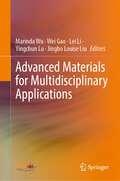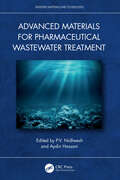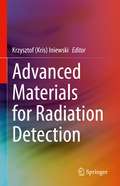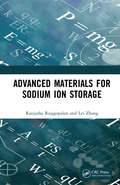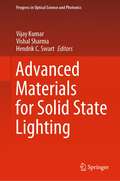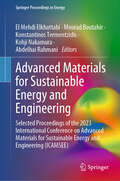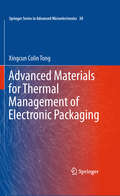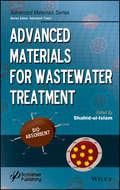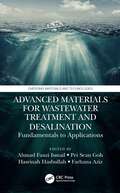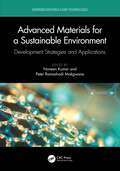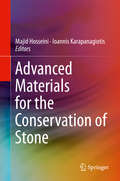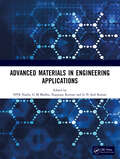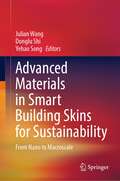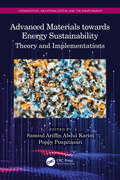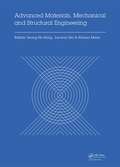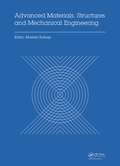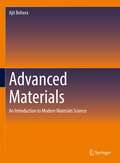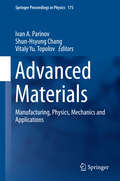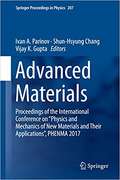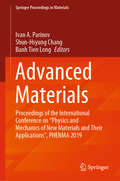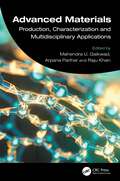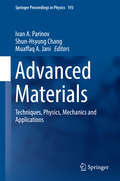- Table View
- List View
Advanced Materials for Multidisciplinary Applications
by Wei Gao Jingbo Louise Liu Lei Li Marinda Wu Yingchun LuThis book provides an overview of recent research in the area of advanced materials for improving human healthcare, protecting the environment and alternative energy resources. The authors analyze and deliver viable technical solutions, demonstrating how chemistry and engineering can collectively solve technical and societal challenges. The book explores innovative technology for the synthesis of complex carbohydrates & glycoproteins, new drug development & delivery, theragnostics of infectious disease and cancer. It also provides insights into the nature of energy extraction, management and usage related to fossil fuels and sustainable energy. The book brings together a group of dynamic and productive scientists, engineers, and other professionals in celebration of the 40th Anniversary of Chinese American Chemical Society. It is a valuable resource for all readers interested in the study of materials to address society's increasing need for electrical and chemical energy.
Advanced Materials for Pharmaceutical Wastewater Treatment (Emerging Materials and Technologies)
by P. V. Nidheesh Aydin HassaniEffluents generated from the pharmaceutical industry contain organic and inorganic contaminants that create potential threats to human health and the environment. Pharmaceuticals cannot be effectively removed by conventional wastewater treatment plants owing to the complex composition, high concentration of organic contaminants, high salinity, and biological toxicity of pharmaceutical wastewater. This book provides an overview of the production and environmental impacts of pharmaceutical compounds and their advanced treatment methods, with a focus on advanced materials used for removing pharmaceutical contaminants from wastewater. Provides an overview of the current state of advanced research and applications of materials for pharmaceutical wastewater treatment Discusses various adsorbents, photocatalysts, and electrodes, with a special focus on carbon materials Covers advanced material synthesis and fabrication Features case studies and chapters that are fully application-oriented This book is essential reading for researchers and practitioners in materials science and engineering, environmental science and engineering, chemical engineering, and water treatment who are seeking to develop and implement advanced technologies for waste minimization and mitigation.
Advanced Materials for Printed Flexible Electronics (Springer Series in Materials Science #317)
by Colin TongThis book provides a comprehensive introduction to printed flexible electronics and their applications, including the basics of modern printing technologies, printable inks, performance characterization, device design, modeling, and fabrication processes. A wide range of materials used for printed flexible electronics are also covered in depth. Bridging the gap between the creation of structure and function, printed flexible electronics have been explored for manufacturing of flexible, stretchable, wearable, and conformal electronics device with conventional, 3D, and hybrid printing technologies. Advanced materials such as polymers, ceramics, nanoparticles, 2D materials, and nanocomposites have enabled a wide variety of applications, such as transparent conductive films, thin film transistors, printable solar cells, flexible energy harvesting and storage devices, electroluminescent devices, and wearable sensors. This book provides students, researchers and engineers with the information to understand the current status and future trends in printed flexible electronics, and acquire skills for selecting and using materials and additive manufacturing processes in the design of printed flexible electronics.
Advanced Materials for Radiation Detection
by Krzysztof Kris IniewskiThis book offers readers an overview of some of the most recent advances in the field of advanced materials used for gamma and X-ray imaging. Coverage includes both technology and applications, with an in-depth review of the research topics from leading specialists in the field. Emphasis is on high-Z materials like CdTe, CZT and GaAs, as well as perovskite crystals, since they offer the best implementation possibilities for direct conversion X-ray detectors. Authors discuss material challenges, detector operation physics and technology and readout integrated circuits required to detect signals processes by high-Z sensors.
Advanced Materials for Sodium Ion Storage
by Lei Zhang Ranjusha RajagopalanGlobally, lithium ion batteries (LIBs) are leaders in the energy storage sector but there are concerns regarding load leveling of renewable energy sources as well as smart grids and limited availability of lithium resources resulting in cost increase. Therefore, sodium ion batteries (SIBs) are being researched as next-generation alternatives to LIBs due to their similar sustainability and electrochemistry. This book mainly focuses on the current research on electrode materials and proposes future directions for SIBs to meet the current challenges associated with the full cell aspect. Further, it provide insights into scientific and practical issues in the development of SIBs.
Advanced Materials for Solid State Lighting (Progress in Optical Science and Photonics #25)
by Vijay Kumar Vishal Sharma Hendrik C. SwartThis book highlights the synthesis, luminescence, and applications of rare earth-doped phosphors materials for solid-state lighting. Solid-state lighting is turning into a leading technology in the lighting industry, permitting improvement in the fields from architectural to domestic applications. Driven with the aid of using ongoing multi-field research, solid-state lighting needs an improvement of various technologies: efficient and reliable light-emitting devices, devices for new functionalities, and optical solutions for beam shaping. Noteworthy research endeavors were aimed to find out eco-friendly, better performance, cost, and energy-efficient phosphor materials for the application in solid-state lighting devices. Power phosphor materials with advanced optical and photoluminescence properties in a wide range of areas have shared the research efforts in this sector aimed in the direction of achieving better material features. Rare earth ion-doped phosphor materials have been the subject of scientific interest because of their significant applications in a variety of fields such as display devices, temperature sensors, solar cells, bio-imaging, and optoelectronics devices. This book covers the broad aspects of organic and inorganic materials based on phosphor materials and is beneficial to researchers involved in these areas. This book is specially designed to provide an introductory concept of luminescent materials, particularly man-made (artificial) phosphors in a language comprehensible to beginners and students. The book also includes some new materials with promising technologies and upgraded properties that expose new potential possibilities are also highlighted.
Advanced Materials for Sustainable Energy and Engineering: Selected Proceedings of the 2023 International Conference on Advanced Materials for Sustainable Energy and Engineering (ICAMSEE) (Springer Proceedings in Energy)
by Konstantinos Termentzidis El Mehdi Elkhattabi Mourad Boutahir Kohji Nakamura Abdelhai RahmaniThis book presents selected peer-reviewed proceedings from the International Conference on Advanced Materials, Sustainable Energy, and Engineering (ICAMSEE2023), held at Ecole Normale Supérieure, University Moulay Ismail Meknes, Morocco, from November 27 to 29, 2023. The conference served as an exceptional platform for international and national scientists, professors, students, and industry professionals to convene and exchange knowledge in the fields of materials science, microscopy, engineering, technology, and energy. The book features contributions from researchers and experts, including keynote speakers, special sessions, posters, and tutorials, showcasing the latest advancements and developments in these areas of research.The topics covered in this book span a wide array of subjects within the realm of advanced materials, sustainable energy, and engineering. The forefront of materials science is explored, including nanomaterials, carbon nanotubes, graphene,materials for various applications, environmental protection, advanced optical materials, thermoelectric and magnetic materials, and additive manufacturing. Addressing the energy demands of today, the focus extends to novel materials for solar cells, energy storage, electronic devices, solar and wind energy, advanced thermal management materials, and materials for advanced water treatment and desalination. Sustainable energy and engineering topics encompass energy policy, clean energy production technologies, carbon capture and utilization, biomass energy, building energy efficiency, smart systems for climate change, and energy efficiency in mineral processing. Additionally, the book covers modeling and numerical simulations in material science, encompassing model development, computational techniques, and simulations in both material science and energy fields.
Advanced Materials for Sustainable Energy and Engineering: Volume 1: Novel Nanomaterials for Sustainable Energy (Engineering Materials)
by Mourad Boutahir Elkhattabi El MehdiThis book delves into the realm of sustainable energy and presents a comprehensive analysis of novel nanomaterials with potential applications in this field. Each chapter offers a unique perspective, contributing to the understanding and development of advanced energy materials. From the infrared spectroscopy analysis of boron nitride nanotubes to the investigation of optical properties of ZnO thin films and the study of double perovskite oxides, this collection covers a wide range of topics. It explores iron-based nitrides, phase change materials for smartphones, thermochromic glazing with vanadium dioxide, and the influence of magnetic pressure on smart materials. The physical properties and applications of 2D phosphorene, carbon nanotube interactions, and metalloporphyrin-encapsulated carbon nanotubes are also discussed. Moreover, the collection investigates the thermal and phonon properties of carbon nanomaterials, optoelectronic properties of perovskite materials, and the physical properties of phosphorene nanotubes. Featuring extended chapters selected as exceptional contributions to the 2023 International Conference on Advanced Materials for Sustainable Energy and Engineering in Meknes, Morocco, this book provides researchers and practitioners with a comprehensive overview of some of the latest advancements in novel nanomaterials. With its interdisciplinary approach and rigorous scientific analysis, this edited collection serves as a valuable resource for those striving to develop sustainable energy solutions for the future.
Advanced Materials for Thermal Management of Electronic Packaging (Springer Series in Advanced Microelectronics #30)
by Xingcun Colin TongThe need for advanced thermal management materials in electronic packaging has been widely recognized as thermal challenges become barriers to the electronic industry's ability to provide continued improvements in device and system performance. With increased performance requirements for smaller, more capable, and more efficient electronic power devices, systems ranging from active electronically scanned radar arrays to web servers all require components that can dissipate heat efficiently. This requires that the materials have high capability of dissipating heat and maintaining compatibility with the die and electronic packaging. In response to critical needs, there have been revolutionary advances in thermal management materials and technologies for active and passive cooling that promise integrable and cost-effective thermal management solutions. This book meets the need for a comprehensive approach to advanced thermal management in electronic packaging, with coverage of the fundamentals of heat transfer, component design guidelines, materials selection and assessment, air, liquid, and thermoelectric cooling, characterization techniques and methodology, processing and manufacturing technology, balance between cost and performance, and application niches. The final chapter presents a roadmap and future perspective on developments in advanced thermal management materials for electronic packaging.
Advanced Materials for Wastewater Treatment
by Shahid Ul-IslamOver the past few decades, rapid industrialization, fast urban encroachment, and improved agricultural operations have introduced substantial amounts of potentially toxic organic substances into the atmosphere and into the aquatic and terrestrial environments. Advanced Materials for Wastewater Treatment brings together innovative methodologies and research strategies to remove toxic effluents from wastewaters.With contributions from leading scientists from all around the world, the book provides a comprehensive coverage of the current literature, up-to-date overviews of all aspects of toxic chemical remediation including the role of nanomaterials.
Advanced Materials for Wastewater Treatment and Desalination: Fundamentals to Applications (Emerging Materials and Technologies)
by Ahmad Fauzi Ismail Pei Sean Goh Hasrinah Hasbullah Farhana AzizAdvanced Materials for Wastewater Treatment and Desalination: Fundamentals to Applications offers a comprehensive overview of current progress in the development of advanced materials used in wastewater treatment and desalination. The book is divided into two major sections, covering both fundamentals and applications. This book: Describes the synthesis and modification of advanced materials, including metal oxides, carbonaceous materials, perovskite-based materials, polymer-based materials, and advanced nanocomposites Examines relevant synthesis routes and mechanisms as well as correlates materials' properties with their characterization Details new fabrication techniques including green synthesis, solvent-free, and energy-saving synthesis approaches Highlights various applications, such as removal of organic contaminants, discoloration of dye wastewater, petrochemical wastewater treatment, and electrochemically-enhanced water treatment With chapters written by leading researchers from around the world, this book will be of interest to chemical, materials, and environmental engineers working on progressing materials applications to improve water treatment technologies.
Advanced Materials for a Sustainable Environment: Development Strategies and Applications (Emerging Materials and Technologies)
by Naveen Kumar Peter Ramashadi MakgwaneThis book summarizes recent and critical aspects of advanced materials for environmental protection and remediation. It explores the various development aspects related to environmental remediation, including design and development of novel and highly efficient materials, aimed at environmental sustainability. Synthesis of advanced materials with desirable physicochemical properties and applications is covered as well. Distributed across 13 chapters, the major topics covered include sensing and elimination of contaminants and hazardous materials via advanced materials along with hydrogen energy, biofuels, and CO2 capture technology. Discusses the development in design of synthesis process and materials with sustainable approach. Covers removal of biotic and abiotic wastes from the aqueous systems. Includes hydrogen energy and biofuels under green energy production. Explores removal of environmental (soil and air) contaminants with nanomaterials. Reviews advanced materials for environmental remediation in both liquid and gas phases.
Advanced Materials for the Conservation of Stone
by Majid Hosseini Ioannis KarapanagiotisThis book identifies novel advanced materials that can be utilized as protective agents for the preservation of stone. The innovative solutions to stone conservation presented here result in increased sustainability, reduced environmental impact, and increased social and economic benefits. It provides an overview of recent trends and progress in advanced materials applied to stone protection. It also explores the scientific principles behind these advanced materials and discusses their applications to diff erent types of stone preservation efforts. Essential information as well as knowledge on the availability and applicability of advanced nanostructured materials is also provided, with focus placed on the practical aspects of stone protection. Th e book highlights an interdisciplinary eff ort regarding novel applications of nanostructured materials in the advancement of stone protection. It provides insight towards forthcoming developments in the fi eld. Advanced nanostructured materials are designed and developed with the aim of being chemically, physically, and mechanically compatible with stone. Advanced materials for stone conservation that are characterized by several functional properties are considered in this book. These include the physico-chemical, protective, and morphological properties, eco-toxicity, and mechanisms of degradation. The authors present a thorough overview of cutting-edge discoveries, detailed information on recent technological developments, breakthroughs in novel nanomaterials, utilization strategies for applications in cultural heritage, and the current status and future outlook of the topic to address a wide range of scientific communities.
Advanced Materials in Engineering Applications: Proceedings of International Conference on Advanced Materials in Engineering Sciences
by Nagaraju Kottam N. V. R. Naidu G. M. Madhu G. N. Anil KumarThe formability features of sheets made of the alloy Al 8011 are examined experimentally and the results are compared with the numerical ones in this research. Through an axisymmetric finite element simulation of the Erichsen cupping test, formability characteristics were evaluated. The Erichsen cupping test was used to exam□ine the effects of several factors, including friction at the punch-sheet contact and sheet thickness. The nonlinear finite element method is used to calculate the dome height, stress, and strain values for the aluminum sheet, and the results are then compared to the numerical ones. The findings demonstrated that the Al 8011 alloy’s form□ability greatly rises with increasing sheet thickness. The formability is significantly impacted by the lubricant. The application of the finite element technique to forecast the formability of Al 8011 alloy.
Advanced Materials in Smart Building Skins for Sustainability: From Nano to Macroscale
by Donglu Shi Julian Wang Yehao SongConventional building skins are constructed as static structures upon the typical design conditions in terms of external climate and internal occupant activities. This generates dissociation between the envelope structure and its environment. With the emerging advanced materials, such as chromic-based materials, spectrally selective coatings, and transparent photovoltaic, more dynamic and smarter building skins are now achievable and constructible. This book updates readers on the key areas of smart building skins embodied in the novel advanced materials with unique structures and smart properties that enable multiple functions in energy efficiency, solar harvesting, and environmental greenness. It synergistically integrates the topics and knowledge of material design and experimental studies, theoretical analyses of building energy-saving mechanisms and solar energy utilization, and new design methodologies and processes taking advanced materials into account at different scales - from nano to the macroscale.
Advanced Materials towards Energy Sustainability: Theory and Implementations (Urbanization, Industrialization, and the Environment)
by Samsul Ariffin Abdul Karim Poppy PuspitasariIndustry 4.0 is revolutionizing the way companies manufacture, improve, and distribute their products. It demands the application of renewable energy using advanced materials. Renewable energy is reshaping the fields of industry, agriculture, and households, providing reliable power supplies and fuel diversification. This enhances energy security, lowers the risk of fuel spills, and reduces the need for imported fuels. Examples of material applications used for renewable energy are photovoltaic, solar cells, which can be used in agriculture. This volume has a diverse audience including students, researchers, and academics engaged in materials and renewable energy. Features : Presents latest research on renewable energy in relation to urbanization, industrialization, and the environment. Provides in-depth discussion on modeling and simulation using latest techniques. Provides technical exposure for the readers on advanced materials. Provides numerous examples on properties of biomaterials and their future prospect. Provides up-to-date information on functional materials for industrial application.
Advanced Materials, Mechanical and Structural Engineering: Proceedings of the 2nd International Conference of Advanced Materials, Mechanical and Structural Engineering (AMMSE 2015), Je-ju Island, South Korea, September 18-20, 2015
by Seung Ho Hong Junwon Seo Kihoon MoonIn the last decades, advanced materials and mechanics has become a hot topic in engineering. Recent trends show that the application of nanotechnology and environmental science together with advanced materials and mechanics are playing an increasingly important role in engineering applications. For catching up with this current trend, this boo
Advanced Materials, Structures and Mechanical Engineering: Proceedings of the International Conference on Advanced Materials, Structures and Mechanical Engineering, Incheon, South Korea, May 29-31, 2015
by Mosbeh KaloopThe International Conference on Advanced Materials, Structures and Mechanical Engineering 2015 (ICAMSME 2015) was held on May 29-31, Incheon, South-Korea. The conference was attended by scientists, scholars, engineers and students from universities, research institutes and industries all around the world to present ongoing research activities. This
Advanced Materials: An Introduction to Modern Materials Science
by Ajit BeheraThis book provides a thorough introduction to the essential topics in modern materials science. It brings together the spectrum of materials science topics, spanning inorganic and organic materials, nanomaterials, biomaterials, and alloys within a single cohesive and comprehensive resource. Synthesis and processing techniques, structural and crystallographic configurations, properties, classifications, process mechanisms, applications, and related numerical problems are discussed in each chapter. End-of-chapter summaries and problems are included to deepen and reinforce the reader's comprehension.Provides a cohesive and comprehensive reference on a wide range of materials and processes in modern materials science;Presents material in an engaging manner to encourage innovative practices and perspectives;Includes chapter summaries and problems at the end of every chapter for reinforcement of concepts.
Advanced Materials: Manufacturing, Physics, Mechanics and Applications (Springer Proceedings in Physics #175)
by Vitaly Yu. Topolov Shun-Hsyung Chang Ivan A. ParinovAdvanced materials are the basis of modern science and technology. This proceedings volume presents a broad spectrum of studies of novel materials covering their processing techniques, physics, mechanics, and applications. The book is concentrated on nanostructures, ferroelectric crystals, materials and composites, materials for solar cells and also polymeric composites. Nanotechnology approaches, modern piezoelectric techniques and also latest achievements in materials science, condensed matter physics, mechanics of deformable solids and numerical methods are presented. Great attention is devoted to novel devices with high accuracy, longevity and extended possibilities to work in wide temperature and pressure ranges, aggressive media etc. The characteristics of materials and composites with improved properties opening new possibilities of various physical processes, in particular transmission and receipt of signals under water, are described.
Advanced Materials: Proceedings Of The International Conference On Physics And Mechanics Of New Materials And Their Applications , PHENMA 2017 (Springer Proceedings In Physics #207)
by Shun-Hsyung Chang Ivan A. Parinov Vijay K. GuptaProvides a consistent and original presentation of fabrication techniques, physics, mechanics, and applications of advanced materials and composites.<p><p> Helps readers to better understand modern R&D requirements for prospective materials and composites.<p> Features original theoretical, experimental and modeling results on novel materials and devices.<p> This book presents selected peer-reviewed contributions from the 2017 International Conference on “Physics and Mechanics of New Materials and Their Applications”, PHENMA 2017 (Jabalpur, India, 14–16 October, 2017), which is devoted to processing techniques, physics, mechanics, and applications of advanced materials. The book focuses on a wide spectrum of nanostructures, ferroelectric crystals, materials and composites as well as promising materials with special properties. It presents nanotechnology approaches, modern environmentally friendly piezoelectric and ferromagnetic techniques and physical and mechanical studies of the structural and physical–mechanical properties of materials. Various original mathematical and numerical methods are applied to the solution of different technological, mechanical and physical problems that are interesting from theoretical, modeling and experimental points of view. Further, the book highlights novel devices with high accuracy, longevity and extended capabilities to operate under wide temperature and pressure ranges and aggressive media, which show improved characteristics, thanks to the developed materials and composites, opening new possibilities for different physico-mechanical processes and phenomena
Advanced Materials: Proceedings of the International Conference on “Physics and Mechanics of New Materials and Their Applications”, PHENMA 2018 (Springer Proceedings in Physics #224)
by Shun-Hsyung Chang Ivan A. Parinov Yun-Hae KimThis book includes selected, peer-reviewed contributions from the 2018 International Conference on “Physics and Mechanics of New Materials and Their Applications”, PHENMA 2018, held in Busan, South Korea, 9–11 August 2018. Focusing on manufacturing techniques, physics, mechanics, and applications of modern materials with special properties, it covers a broad spectrum of nanomaterials and structures, ferroelectrics and ferromagnetics, and other advanced materials and composites. The authors discuss approaches and methods in nanotechnology; newly developed, environmentally friendly piezoelectric techniques; and physical and mechanical studies of the microstructural and other properties of materials. Further, the book presents a range of original theoretical, experimental and computational methods and their application in the solution of various technological, mechanical and physical problems. Moreover, it highlights modern devices demonstrating high accuracy, longevity and the ability to operate over wide temperature and pressure ranges or in aggressive media. The developed devices show improved characteristics due to the use of advanced materials and composites, opening new horizons in the investigation of a variety of physical and mechanical processes and phenomena.
Advanced Materials: Proceedings of the International Conference on “Physics and Mechanics of New Materials and Their Applications”, PHENMA 2019 (Springer Proceedings in Materials #6)
by Shun-Hsyung Chang Ivan A. Parinov Banh Tien LongThis book presents selected peer-reviewed contributions from the 2019 International Conference on “Physics and Mechanics of New Materials and Their Applications”, PHENMA 2019 (Hanoi, Vietnam, 7–10 November, 2019), divided into four scientific themes: processing techniques, physics, mechanics, and applications of advanced materials. The book describes a broad spectrum of promising nanostructures, crystals, materials and composites with special properties. It presents nanotechnology approaches, modern environmentally friendly techniques and physical-chemical and mechanical studies of the structural-sensitive and physical–mechanical properties of materials. The obtained results are based on new achievements in material sciences and computational approaches, methods and algorithms (in particular, finite-element and finite-difference modeling) applied to the solution of different technological, mechanical and physical problems. The obtained results have a significant interest for theory, modeling and test of advanced materials. Other results are devoted to promising devices demonstrating high accuracy, longevity and new opportunities to work effectively under critical temperatures and high pressures, in aggressive media, etc. These devices demonstrate improved comparative characteristics, caused by developed materials and composites, allowing investigation of physio-mechanical processes and phenomena based on scientific and technological progress.
Advanced Materials: Production, Characterization and Multidisciplinary Applications
by Raju Khan Arpana Parihar Mahendra U. GaikwadAdvanced materials are engineered to exhibit novel properties that confer superior performance in comparison with conventional materials. The performance of advanced materials is associated with toughness, hardness, and durability that can be used for high technological applications such as semiconductors, biomaterials, smart materials, or nanomaterials.Advanced Materials: Production, Characterization and Multidisciplinary Applications is focused on novel approaches for production of graphene and other 2D materials along with characterization techniques, discussing a wide range of applications in multidisciplinary areas of science and engineering. It provides a guiding light in the production, synthesis, and characterization of advanced materials by implementing appropriate techniques. The book has a multidisciplinary approach covering applications in electronics (sensors), engineering, biotechnology, medical (e.g., cancer treatment, drug delivery, cellular imaging), and biomedical (smart implants, drug delivery, and DIY health testing kits) fields. The authors cover the primary information of advanced and other 2D materials related to their production or synthesis via various methods, ranging from conventional to non‑conventional – such as lithography, photolithography (computer chips), electron beam lithography, etching, atomic layer deposition, chemical vapor deposition, hydrothermal process, and electrospinning, along with some comparative investigations. It also covers a comparison study over the current and future perspectives of advanced and other 2D materials.This book is aimed at researchers, academics, and professionals who are interested in understanding the novel approaches for synthesis of advanced materials.
Advanced Materials: Techniques, Physics, Mechanics and Applications (Springer Proceedings in Physics #193)
by Shun-Hsyung Chang Ivan A. Parinov Muaffaq A. JaniAdvanced materials and their applications based on nanotechnology and piezoelectric approaches are a tremendous interest in modern science and techniques. This book presents processing techniques, physics, mechanics, and applications of novel materials. The book concentrates on some nanostructures, ferro- and magnetoelectric crystals, materials and composites, materials for solar cells and polymeric composites. There are present nanotechnology approaches, modern piezoelectric techniques, and also studies of the structure-sensitive properties of the materials. Great attention is devoted to novel devices with high accuracy, longevity and extended possibilities to work with wide temperature and pressure ranges, which show characteristics defined by used materials and composites with improved properties opening new possibilities in the study of various physical processes, in particular the transmission and receipt of signals under water.
